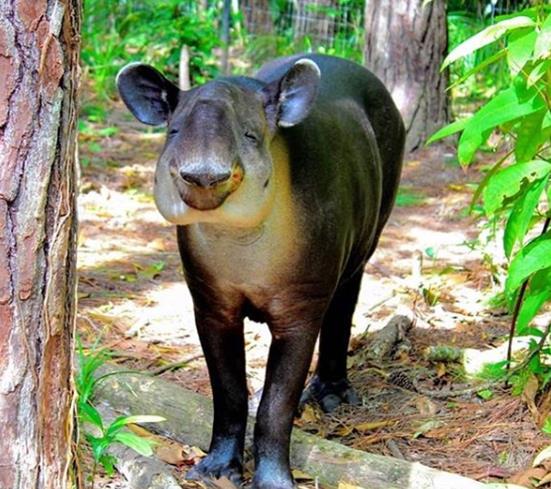
Biology
Height: 3 ft
Weight: 300 - 550 lbs
Lifespan: 20 - 25 years
# of offspring: 1
Gestation period: 13 months
Range & Habitat
Habitats: Humid tropical forests; lowland savanna; pine woodlands; riparian forests; mangrove and coastal scrub forests; montane forests
Food & Function
Lifestyle: Crepuscular; Terrestrial
Ecological roles: Seed disperser. Nutrient recycler. Bio-indicator.
Central American Tapir 
(Tapirus bairdii)
Spanish: Danto. Belizean Creole: Mountain Cow
The tapir is the largest native mammal in Central America, and the National Animal of Belize. They are odd-toed ungulates, and closely related to horses, rhinos, and donkeys.
A tapir’s prehensile snout has a highly developed sense of smell, and is also an excellent tool for grasping leaves and fruit. Their sensitive hearing also helps them navigate their environment in poor light conditions; while generally considered to be crepuscular, they are also quite comfortable moving around at night.
They occupy a range of different habitats, but are always close to bodies of water. Tapirs are excellent swimmers, and feel right at home in rivers, ponds, lakes, and streams.
Their ability to consume large fruits with large seeds makes them an important agent for seed dispersal in our forests. All the plant matter they consume is recycled back into the soil as nutrients in their poop.
Fun Facts
- Tapir calves are born with spots and stripes for camouflage, and lose them at around 5 months of age. Think of them as “watermelons with legs”
- They are often referred to as “living fossils” as their species has been around for millions of years
- The Central American tapir is the second largest species of tapir in the world
- Tapirs communicate through a series of high pitched whistles, whines, and squeaks
Belize Zoo Trivia
- April the tapir was TBZ’s first and most famous animal ambassador. Arriving at the Zoo as a rescued calf in 1983, April’s birthday was celebrated by hundreds of Belizeans for 30 years before her passing in 2013
- National Tapir Day is celebrated at The Belize Zoo every year in April to coincide with World Tapir Day (April 27th).
- Our “tapir troop” currently consists of Indy, Tambo, Marchismo, Navidad, Fuego, Sparks, and Ceibo. Marchismo and Sparks are the only two tapirs ever born at the Zoo.
- Cecropia leaves are one of the tapir’s favourite snacks.
Conservation Efforts
Central American tapirs are a globally Endangered species. They are locally extinct in parts of their range, including El Salvador, and parts of Guatemala. While Belize is considered a stronghold for the species, their biggest threats here are deforestation and lethal collisions by vehicles at night.
The Belize Tapir Project is one of the leading efforts working to halt the decline of Belize’s tapir population through research, road safety interventions, advocacy, and education.
